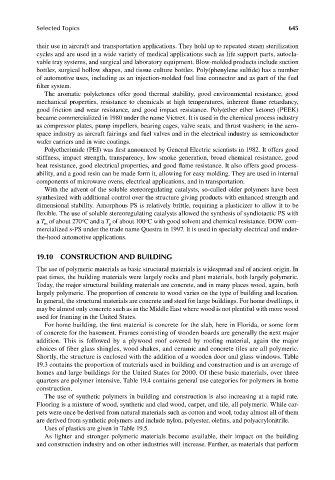Page 682 - Carrahers_Polymer_Chemistry,_Eighth_Edition
P. 682
Selected Topics 645
their use in aircraft and transportation applications. They hold up to repeated steam sterilization
cycles and are used in a wide variety of medical applications such as life support parts, autocla-
vable tray systems, and surgical and laboratory equipment. Blow-molded products include suction
bottles, surgical hollow shapes, and tissue culture bottles. Poly(phenylene sulfide) has a number
of automotive uses, including as an injection-molded fuel line connector and as part of the fuel
fi lter system.
The aromatic polyketones offer good thermal stability, good environmental resistance, good
mechanical properties, resistance to chemicals at high temperatures, inherent fl ame retardancy,
good friction and wear resistance, and good impact resistance. Poly(ether ether ketone) (PEEK)
became commercialized in 1980 under the name Victrex. It is used in the chemical process industry
as compressor plates, pump impellers, bearing cages, valve seats, and thrust washers; in the aero-
space industry as aircraft fairings and fuel valves and in the electrical industry as semiconductor
wafer carriers and in wire coatings.
Polyetherimide (PEI) was fi rst announced by General Electric scientists in 1982. It offers good
stiffness, impact strength, transparency, low smoke generation, broad chemical resistance, good
heat resistance, good electrical properties, and good flame resistance. It also offers good process-
ability, and a good resin can be made form it, allowing for easy molding. They are used in internal
components of microwave ovens, electrical applications, and in transportation.
With the advent of the soluble stereoregulating catalysts, so-called older polymers have been
synthesized with additional control over the structure giving products with enhanced strength and
dimensional stability. Amorphous PS is relatively brittle, requiring a plasticizer to allow it to be
flexible. The use of soluble stereoregulating catalysts allowed the synthesis of syndiotactic PS with
o
o
a T of about 270 C and a T of about 100 C with good solvent and chemical resistance. DOW com-
m g
mercialized s-PS under the trade name Questra in 1997. It is used in specialty electrical and under-
the-hood automotive applications.
19.10 CONSTRUCTION AND BUILDING
The use of polymeric materials as basic structural materials is widespread and of ancient origin. In
past times, the building materials were largely rocks and plant materials, both largely polymeric.
Today, the major structural building materials are concrete, and in many places wood, again, both
largely polymeric. The proportion of concrete to wood varies on the type of building and location.
In general, the structural materials are concrete and steel for large buildings. For home dwellings, it
may be almost only concrete such as in the Middle East where wood is not plentiful with more wood
used for framing in the United States.
For home building, the first material is concrete for the slab, here in Florida, or some form
of concrete for the basement. Frames consisting of wooden boards are generally the next major
addition. This is followed by a plywood roof covered by roofing material, again the major
choices of fiber glass shingles, wood shakes, and ceramic and concrete tiles are all polymeric.
Shortly, the structure is enclosed with the addition of a wooden door and glass windows. Table
19.3 contains the proportion of materials used in building and construction and is an average of
homes and large buildings for the United States for 2000. Of these basic materials, over three
quarters are polymer intensive. Table 19.4 contains general use categories for polymers in home
construction.
The use of synthetic polymers in building and construction is also increasing at a rapid rate.
Flooring is a mixture of wood, synthetic and clad wood, carpet, and tile, all polymeric. While car-
pets were once be derived from natural materials such as cotton and wool, today almost all of them
are derived from synthetic polymers and include nylon, polyester, olefins, and polyacrylonitrile.
Uses of plastics are given in Table 19.5.
As lighter and stronger polymeric materials become available, their impact on the building
and construction industry and on other industries will increase. Further, as materials that perform
9/14/2010 3:44:05 PM
K10478.indb 645 9/14/2010 3:44:05 PM
K10478.indb 645

